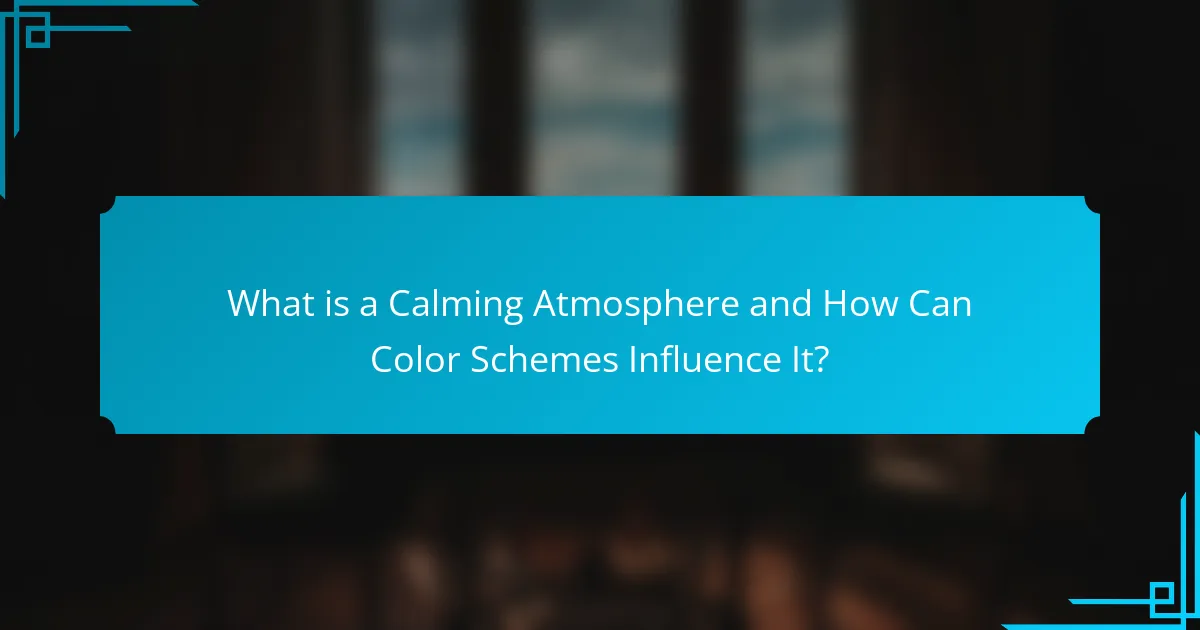Creating a calming atmosphere is essential for promoting relaxation and reducing stress. This article focuses on the use of cool color schemes, specifically shades of blue, green, and purple, which have been shown to evoke feelings of tranquility. Research highlights that cool colors can lower heart rates and enhance serenity, making them effective in design for serene environments. Techniques such as color blocking and the incorporation of soft, muted shades, along with appropriate lighting, are discussed to achieve a harmonious and calming space. The psychological impacts of these colors further support their application in environments intended for relaxation.

What is a Calming Atmosphere and How Can Color Schemes Influence It?
A calming atmosphere is an environment that promotes relaxation and reduces stress. It can be achieved through various elements, including lighting, sound, and color schemes. Color schemes, particularly cool colors like blue and green, have a significant influence on creating a calming atmosphere. Research indicates that cool colors can lower heart rates and promote feelings of tranquility. For instance, a study published in the Journal of Environmental Psychology found that blue hues can enhance feelings of peace and serenity. Thus, incorporating cool colors into a space can effectively contribute to a calming atmosphere.
How do cool color schemes contribute to a calming atmosphere?
Cool color schemes contribute to a calming atmosphere by evoking feelings of tranquility and relaxation. Shades such as blue, green, and lavender are associated with nature and serenity. These colors can lower heart rates and reduce feelings of anxiety. Research indicates that blue light can have a calming effect on the mind. In environments painted with cool colors, individuals often report feeling more at ease. This is supported by studies showing that color influences mood and behavior. For instance, a study published in the journal “Color Research and Application” found that cool colors promote a sense of peace. Therefore, incorporating cool color schemes can effectively foster a soothing environment.
What specific cool colors are commonly used for creating calmness?
Specific cool colors commonly used for creating calmness include blue, green, and lavender. Blue is often associated with tranquility and serenity. Studies show that blue can lower heart rates and reduce stress. Green evokes feelings of nature and renewal. Research indicates that green spaces promote relaxation and mental well-being. Lavender, a soft shade of purple, is linked to peace and calm. Its soothing effects are well-documented in color psychology. These colors are frequently utilized in design and decor to foster a calming environment.
How do these cool colors affect emotions and perceptions?
Cool colors, such as blue, green, and purple, primarily evoke feelings of calmness and relaxation. These colors are associated with nature, water, and tranquility. Research indicates that blue can lower heart rates and reduce anxiety levels. A study published in the journal “Color Research and Application” found that blue light exposure can enhance feelings of serenity. Green is linked to renewal and balance, promoting a sense of harmony. Purple can inspire creativity while maintaining a soothing effect. Cool colors are often used in design to create peaceful environments, influencing perceptions positively.
Why is it important to consider color schemes in interior design?
Color schemes are crucial in interior design because they influence mood and perception. The right colors can create a calming atmosphere, enhancing overall well-being. For example, cool colors like blues and greens are known to evoke tranquility. Studies show that these colors can lower stress levels and promote relaxation. Additionally, color schemes affect spatial perception and can make spaces feel larger or cozier. Research indicates that thoughtful color choices can increase productivity and creativity in workspaces. Therefore, considering color schemes is essential for achieving desired emotional and aesthetic outcomes in interior environments.
What role does color play in psychological responses to space?
Color significantly influences psychological responses to space. Different colors evoke specific emotional reactions. For example, blue is often associated with calmness and tranquility. Green can promote feelings of balance and harmony. Warm colors like red may stimulate energy and excitement. The context of color also matters; light colors can make a space feel larger. Dark colors might create a more intimate atmosphere. Research indicates that color can affect mood and behavior. A study by Küller et al. (2009) found that color temperature impacts perceived comfort in environments. Thus, color plays a crucial role in shaping psychological experiences within spaces.
How can color schemes enhance overall well-being in living spaces?
Color schemes can enhance overall well-being in living spaces by influencing mood and emotions. Specific colors can evoke feelings of calmness, happiness, or energy. For example, blue shades are associated with tranquility and can reduce stress levels. Research shows that environments with cooler colors can lower heart rates and promote relaxation. Studies indicate that green hues can improve focus and enhance creativity. Warm colors, like yellows and oranges, can stimulate energy and positivity. The choice of color not only affects psychological states but also impacts physical responses. Properly selected color schemes can create a harmonious atmosphere that supports mental health and well-being.

What are the Different Shades of Cool Colors?
Cool colors include shades of blue, green, and purple. Common shades of blue are navy, sky blue, and teal. Green shades often found in cool color palettes include mint, emerald, and seafoam. Purple shades encompass lavender, violet, and indigo. These colors are known for their calming effects. They are often used in design to create serene environments. Research shows that cool colors can lower heart rates and reduce stress. This supports their use in spaces intended for relaxation.
What are the primary shades of cool colors used in design?
The primary shades of cool colors used in design include blue, green, and purple. Blue is often associated with calmness and tranquility. It can range from light sky blue to deep navy. Green represents nature and renewal. Shades can vary from soft mint to dark forest green. Purple conveys creativity and luxury. It includes hues like lavender and deep violet. These colors are commonly used to create a soothing environment in design.
How do light and dark shades of cool colors differ in effect?
Light and dark shades of cool colors create different emotional effects. Light shades, such as sky blue or soft lavender, tend to evoke feelings of tranquility and openness. These colors can make spaces feel airy and expansive. Dark shades, like navy blue or deep teal, often convey depth and sophistication. They can create a sense of intimacy and coziness in a room. Research indicates that lighter colors can enhance mood and promote relaxation, while darker shades may foster contemplation and focus. Studies in color psychology support these distinctions, showing how hues impact emotional responses and perceived space.
What are some examples of each primary shade in use?
The primary shades in use for creating a calming atmosphere with cool color schemes include blue, green, and purple. Blue can be seen in serene ocean-themed interiors, promoting tranquility. Green is often used in nature-inspired designs, such as leafy decor, to evoke freshness. Purple appears in soft lavender accents, creating a soothing ambiance. These shades are frequently chosen for their psychological effects, enhancing relaxation and peace in various environments.
How can variations in cool colors influence the ambiance?
Variations in cool colors can significantly influence the ambiance by creating a calming and serene environment. Cool colors, such as blue, green, and violet, are known to evoke feelings of tranquility. These colors can lower heart rates and reduce stress levels, contributing to a peaceful atmosphere. For example, studies show that blue light can enhance relaxation and improve mood. In interior design, lighter shades of blue can make a space feel more open and airy. Similarly, soft greens can promote a connection to nature, enhancing feelings of comfort. The choice of cool color variations can also affect spatial perception, making rooms appear larger and more inviting.
What are the effects of pastel cool colors compared to vibrant shades?
Pastel cool colors create a calming, soothing atmosphere. They promote relaxation and tranquility. In contrast, vibrant shades are energizing and stimulating. Vibrant colors can increase excitement and activity levels. Research indicates that pastel hues can reduce stress and anxiety. A study by K. A. Kuller found that soft colors positively impact mood. Vibrant colors can evoke strong emotional responses but may lead to overstimulation. This contrast highlights how color choice influences emotional and psychological effects.
How do different combinations of cool colors work together?
Different combinations of cool colors work together by creating harmonious and calming effects. Cool colors include shades of blue, green, and violet. These colors can evoke feelings of tranquility and relaxation. When paired, they enhance each other’s soothing qualities. For example, blue and green together can mimic natural landscapes, promoting serenity. Additionally, using varying shades of these colors can add depth and interest. Color theory supports that analogous color schemes, which use adjacent cool colors, create visual cohesion. This principle is widely applied in interior design to foster peaceful environments.

What Techniques Can Be Used to Create a Calming Atmosphere with Color Schemes?
To create a calming atmosphere with color schemes, utilize cool colors such as blues, greens, and purples. These colors are known to evoke feelings of tranquility and relaxation. Incorporating soft, muted shades can enhance the calming effect. Use color blocking techniques to create harmonious spaces. Balance the use of color with neutral tones to avoid overwhelming the senses. Lighting also plays a crucial role; soft, diffused lighting complements cool colors effectively. Additionally, consider the psychological impact of colors; studies show that blue can lower heart rates and reduce anxiety. By applying these techniques, a calming environment can be achieved through thoughtful color choices.
What are effective strategies for incorporating cool colors into a space?
Use a balanced color palette to incorporate cool colors effectively. Combine cool shades like blues, greens, and purples with neutral tones. This creates a harmonious environment. Consider painting walls in soft blue or green hues. These colors promote relaxation and calmness. Use cool-colored furnishings or decor to enhance the atmosphere. Accessories like cushions, rugs, or artwork can introduce these shades. Layer different cool tones for depth and interest. This technique can prevent a flat appearance. Natural light can enhance the effect of cool colors. Position mirrors to reflect light and amplify the color scheme.
How can color placement impact the perception of space?
Color placement can significantly influence the perception of space. Strategic use of colors can create an illusion of depth and dimension. Light colors tend to make spaces feel larger and more open. Dark colors can create a cozy, intimate atmosphere but may visually shrink a room.
For example, painting the ceiling a lighter shade can make it appear higher. Similarly, using a darker color on one wall can create a focal point, drawing the eye and altering spatial perception. Research indicates that color affects mood and spatial awareness; studies show that lighter hues can enhance feelings of openness and tranquility.
What design elements should be considered alongside color schemes?
Design elements that should be considered alongside color schemes include typography, layout, texture, and imagery. Typography affects readability and mood. The right font can enhance the calming effect of cool colors. Layout influences the arrangement of elements and overall flow. A well-structured layout can promote tranquility. Texture adds depth and interest to a design. It can complement color choices and create a soothing experience. Imagery, such as photographs or illustrations, should align with the color scheme. Appropriate images can reinforce the calming atmosphere intended by the color selection.
How can lighting enhance the effects of cool color schemes?
Lighting can enhance the effects of cool color schemes by influencing mood and perception. Proper lighting can amplify the calming qualities of cool colors like blues and greens. Soft, diffused lighting creates a serene environment that complements these shades. Conversely, harsh lighting can make cool colors appear stark and uninviting. Additionally, the color temperature of light can affect how cool colors are perceived. For instance, cooler light temperatures can intensify the refreshing feel of blue hues. Studies show that well-lit spaces with cool colors can lower stress levels and promote relaxation. Therefore, strategic lighting choices are essential for maximizing the benefits of cool color schemes.
What types of lighting work best with cool colors?
Cool colors work best with cool lighting types. LED lights with a cool white or daylight color temperature enhance the calming effect of cool colors. Fluorescent lights in the cool spectrum also complement these shades effectively. These lighting types maintain a balanced ambiance that supports relaxation and tranquility. Research indicates that cooler light temperatures can positively influence mood and perception of space. For instance, a study published in the Journal of Environmental Psychology found that cooler light enhances feelings of calmness in spaces decorated with cool colors.
How does natural light interact with cool color schemes?
Natural light enhances cool color schemes by making them appear more vibrant and refreshing. When natural light enters a space, it interacts with cool colors like blues and greens, amplifying their soothing qualities. This interaction can create a serene atmosphere, promoting relaxation and calmness. Studies show that natural light can influence color perception, making cool tones feel more inviting. Furthermore, the angle and intensity of light affect how these colors are experienced throughout the day. In well-lit environments, cool colors can evoke feelings of tranquility and spaciousness, contributing to a calming ambiance.
What are some practical tips for creating a calming atmosphere with cool colors?
Use cool colors like blue and green to create a calming atmosphere. These colors are known to reduce stress and promote relaxation. Incorporate soft shades rather than bright, intense hues. Paint walls in light blue or soft green for a soothing backdrop. Use cool-colored decor items like cushions or curtains to enhance the effect. Lighting also plays a crucial role; opt for soft, diffused lighting to complement cool colors. Natural light can amplify the calming effect, so maximize window space. Lastly, consider adding plants with cool-toned foliage, as they can further enhance tranquility.
Creating a calming atmosphere with cool color schemes is the primary focus of this article. It explores how colors such as blue, green, and lavender can evoke feelings of tranquility, reduce stress, and enhance overall well-being. Key sections discuss the psychological effects of color, the importance of color placement in interior design, and effective strategies for incorporating these colors into spaces. Additionally, the article examines the role of lighting and texture in amplifying the calming effects of cool colors, providing practical tips for achieving a serene environment.